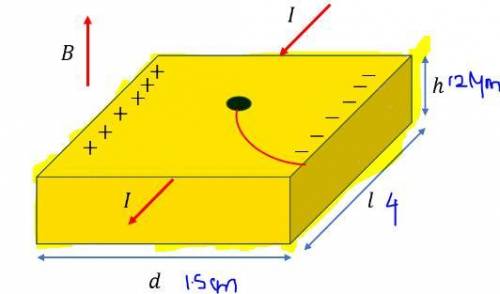
Physics, 25.12.2019 05:31 raywalker3410
In a hall-effect experiment, a current of 3.7 a sent lengthwise through a conductor 1.5 cm wide, 4.0 cm long, and 12 μm thick produces a transverse (across the width) hall potential difference of 78 μv when a magnetic field of 0.76 t is passed perpendicularly through the thickness of the conductor.
a) find the drift velocity of the charge carriers and the number density of charge carriers.
b) show on a diagram the polarity of the hall potential difference.

Answers: 3


Other questions on the subject: Physics

Physics, 22.06.2019 06:00, Bengynease2598
What will a positive and a negative charge do if they are separated from each other?
Answers: 3

Physics, 22.06.2019 14:00, astigall4272
What is the force that opposes motion and works against the downward pull? a) friction b) gravity c) weight d) acceleration
Answers: 1

Physics, 22.06.2019 18:30, leslylinares454
Abaseball is thrown from the outfield toward the catcher. when the ball reaches its highest point, which statement is true? (a)its velocity is not zero, but its acceleration is zero. (b) its velocity and its acceleration are both zero. (c) its velocity is perpendicular to its acceleration. (d) its acceleration depends on the angle at which the ball was thrown. (e) none of the above statements are true.
Answers: 1

Physics, 23.06.2019 01:30, eliascampos823
Acyclotron is used to produce a beam of high-energy deuterons that then collide with a target to produce radioactive isotopes for a medical procedure. deuterons are nuclei of deuterium, an isotope of hydrogen, consisting of one neutron and one proton, with total mass 3.34×10−27kg. the deuterons exit the cyclotron with a kinetic energy of 6.40 mev .a-what is the speed of the deuterons when they exit? b-if the magnetic field inside the cyclotron is 1.25 t, what is the diameter of the deuterons' largest orbit, just before they exit? c-if the beam current is 350 μa how many deuterons strike the target each second?
Answers: 3
You know the right answer?
In a hall-effect experiment, a current of 3.7 a sent lengthwise through a conductor 1.5 cm wide, 4.0...
Questions in other subjects:

Computers and Technology, 13.11.2019 01:31

Mathematics, 13.11.2019 01:31

History, 13.11.2019 01:31



Mathematics, 13.11.2019 01:31


Biology, 13.11.2019 01:31










